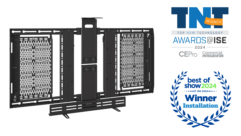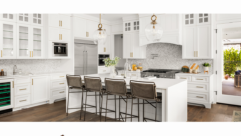
AV-Enhanced Teaching Guides Facility Project
A new facility on the Boulder campus of the University of Colorado beckons students to explore the synergy among technology, society, media and the arts.
CHALLENGE: Equip a university facility with tools that let students readily use AV technology to enhance and share the learning experience.
SOLUTION: Design and outfit a flexible black- box performance space with tools such as movable mixing, and link it to learning environments where production nuances can be taught.
Dancers from a U. of Colorado at Boulder interdisciplinary course in music and dance interact with video cameras and digital music at a performance in the Atlas Institute experimental black box.
A new facility on the Boulder campus of the University of Colorado beckons students to explore the synergy among technology, society, media and the arts. More than a decade in planning, the ambitious learning enhancement capabilities envisioned for the Alliance for Technology, Learning and Society Institute, or Atlas, building were highly coveted. Student supporters were so committed to the concept, they lobbied the administration to levy a special student fee to raise $20 million to plug a funding gap that had mothballed and threatened to derail the project.
But securing funding was only half the battle. The task of building a highly flexible AV environment in the versatile structure tested the skills of a team of consultants, architects, builders, AV systems designers and integrators.
The $31 million, five-story structure incorporates a $2.25 million AV production and presentation system. It also features studios for campus news broadcasts and various AV-centric teaching and learning venues.
It was painstakingly designed to let students use advanced AV tools as effortlessly as possible and in a variety of readily accessed, cross-purposed applications.
The AV tools are deployed in a versatile package across multiple venues that include an auditorium, film screening room, video production control rooms, production studios and a performance space. The tools are used to enhance teaching and self-directed learning in disciplines as diverse as dance, theater, film, television production and journalism.
The need to ensure both interconnectivity as well as the standalone capabilities of each venue dominated the initial concept of Walters-Storyk Design Group (WSDG), Highland, N.Y., as it worked to specify AV components and design a multipurpose space that is easy to use.
“It’s not every day that you have a project where there are five or six different room types such as these, all of which must be melded together and relate to each other inside of a complex building like Atlas,” says John Storyk, a co-principal with the group.
HOUSINGS PROTECT ATLAS’ EXTERIOR LCDS
A college campus facility devoted to fundamentally changing how people think about converging technology and learning shouldn’t be shrouded in mystery: That was the thinking behind the Atlas building on the University of Colorado Boulder campus to install three informational LCDs on the outside wall of the facility.
To make that work in Boulder’s harsh climate, 42-inch custom displays from LG Electronics had to shielded from the elements. Display Devices of Arvada, Colo., designed and built flat-panel enclosures to protect the displays. Made of stainless steel with a half-inch poly-carbonate window, the egg-shaped enclosures have an RS-232 thermostatic surface. The enclosures have integrated air conditioning and heating.
The Atlas project AV systems integrator, Ceavco Audio Visual, worked closely with Display Devices to design and install the enclosures. “Installing them was a learning project,” says Ceavco’s project manager Daryl Surface. “The big hurdle was dealing with the size and weight of the units.”
Protected from the elements, the displays, which carry images relating to the AV-enhanced projects taking place inside, let the rest of the university in on what’s happening behind Atlas’ walls.
“We extended the media displays to the exterior to draw people in and showcase what’s going on inside,” says Bobby Schnabel, vice provost for academic and campus technology.
Each venue posed special integration challenges, but none more than the hallmark performance space. Dubbed the “black box,” partly to convey its inherent creative flexibility and open technology, the two-story, 2,300-square foot space is designed and equipped to give users latitude in experimenting with AV-enabled staging, production and recording.
“The black box was probably the most challenging venue, because of the openness of its design and its need for flexibility,” says Judy Elliott-Brown, who led WSDG’s AV systems design effort. “It was designed with no fixed mixing or microphone positions and no single stage area.”
Instead, portability, connectivity and easy configurability define the space. For example, users can roll in a Mackie Onyx 3280 LCR live audio mixing console, connect it to either of two floor or one booth plug-in locations and attain instant mixing capabilities. A complement of fixed and wireless microphones, including Sennheiser MD421 wireless and Shure SM-57 and Beta 58 mics, are linked to four XTA DS-800, eight-channel, 1×4 mic splitters that tie into the Onyx and audio mixing consoles housed in separate audio and video recording rooms.
“It would not have been possible to make this space work without movable mixing,” says Elliott-Brown.
Lacking a fixed stage, the venue’s audio system had to be designed to permit shifts in loudspeaker imaging to match a movable center stage for each performance. To attain that flexibility, four Meyer Sound Laboratories UPA-1P loudspeakers were flown in each of the rectangular space’s four corners. Their inputs, as well as that of other temporary speakers that can be flown from tension grids in the space as needed, are processed through a BSS London Z-Blu-80, 8×8 LCR DSP processor. The unit’s robust processing and storage capabilities made it the ideal choice for processing audio in a flexible space.
“With its floating DSP building blocks and the ability to handle EQ and crossovers for the full-range speakers, the BSS processor allows you to construct what you want,” says Elliott-Brown. “With its multiple presets, the processor accommodates all image shifts, as well as any mixing format, from mono to 7.1, and makes it possible to produce a left-right image on any wall.”
The room’s video capabilities are equally flexible. Five Sony VPL-CX70 portable projectors are dedicated to the space, allowing users to choose images to complement their work in any area. Other fixed projection components include a Barco RLM G5i high-resolution projector, an Extron PIP 444 image display processor, and a Stewart Filmscreen projection screen. Two Marshall V-R221P-V, 22-inch broadcast LCD displays deliver video to the space from multiple sources.
While its primary function is a performance space, the black box can serve as a laboratory for learning in the facility’s AV recording, editing and production venues. In one of two side-by-side video production control rooms, students have access to a complement of AV gear to work with performance-space content. Both are equipped with Echolab Nova 1716x 16-input video switchers, a single Chyron Duet Micro character generator, Miranda Kaleido-Alto character generators, Mackie SR 24.4 audio mixing consoles and a complement of LCD displays and color monitors. When a sliding glass partition is opened, the two rooms become one, and the gear is readily viewable and accessed for use in a hands-on classroom environment.
In the other room, the same equipment is used to produce live campus news broadcasts that originate in an adjacent video production studio, and live sports broadcasts fed via a fiber-optic cable connection to the campus stadium. Three Sony DXC-D50WS cameras feed studio-based productions to the video production control room for taping or live distribution.
Journalism students operate video and sound boards during a news broadcast within the production facilities in the new Atlas Institute Building at the University of Colorado at Boulder.
For systems integrator Ceavco Audio Visual of Arvada, Colo., the production areas were a particular challenge from an infrastructure build-out standpoint. While some level of interconnections among all venues was a defining part of the Atlas design, the demands of bringing the production system design to life were notably stiff.
“It was challenging in terms of integration, because of the sheer volume of SDI cable that had to be pulled, and the need to connect with patch panels ahead of and behind a couple of fairly large video routers, one a Network VD6464 SDI video router, and the other a Network V3232 analog video router,” says Gary Sutton, Ceavco senior design engineer. “There were a lot of hours spent building out 10 racks of SDI gear for the rooms at our off-site shop, testing them out in a controlled environment, and then installing them at the building.”
A facility such as Atlas wouldn’t be complete without a hearty complement of high-caliber presentation and teaching spaces. WSDG designed and specified equipment for both a 150-seat auditorium and a 75-seat film screening room that have few boundaries when it comes to delivering content.
Used for lectures and distance learning classes, the auditorium’s audio system, featuring a Dolby CP 650 Sound Processor, accommodates simple, mono mic presentations to audio for 5.1 DVD-based presentations. A Stewart Filmscreen Ultimate 200 Perforated Screen displays images from a versatile Barco RLM G5i projector.
“The Barco has an internal four-way split to allow projection of up to four images on the screen at once,” says Elliott-Brown.
FOR MORE INFORMATION
Mackiewww.mackie.com
Sennheiserwww.sennheiserusa.com
Shurewww.shure.com
Meyer Soundwww.meyersound.com
Sonywww.sony.com
Echolabwww.echolab.com
Extronwww.extron.com
Stewart Filmscreenwww.stewartfilmscreen.com
Marshallwww.lcdracks.com
Chyronwww.chyron.com
Networkwww.network-electronics.no
The screening room’s defining technology is a Sony RX-105 2K video projector capable of projecting images close to digital-cinema resolution. Complemented by a movable screen-masking package accompanying a Stewart Ultramatte 130 Micro Perf 8×22 screen, the room has the flexibility to screen both 35mm and 16mm films.
As the curtain draws on the Atlas facility’s first full school year of operation, campus officials in charge of this unique approach of melding teaching and the best possible AV technology are excited for the university and, most of all, its students. Bret Mann, technical manager for Atlas, says the design-integration team delivered a facility that few college students outside the Boulder campus can experience.
“It is a turnkey solution to the needs of students and faculty wishing to produce and share their works with the world at large, a solution empowered by a comprehensive menu of professional quality tools and support,” he says.
Bobby Schnabel, director of Atlas Institute, says the facility’s ease of use and flexibility obscure an intensive and challenging behind-the-scenes design and technology integration effort.
“WSDG worked with us on every level, from the big picture down to pixel level details in control room and acoustical design,” he says.
Tom Zind is a freelance writer based in Lee’s Summit, Mo.










